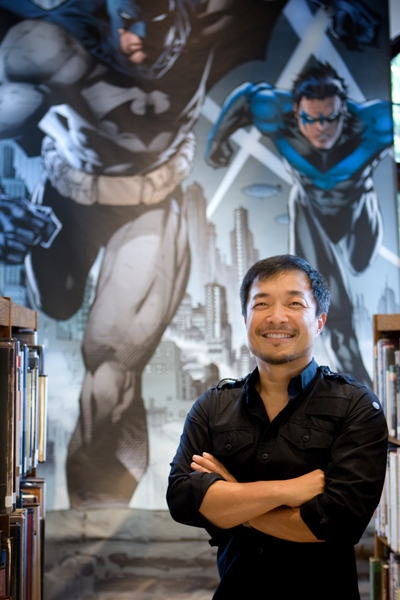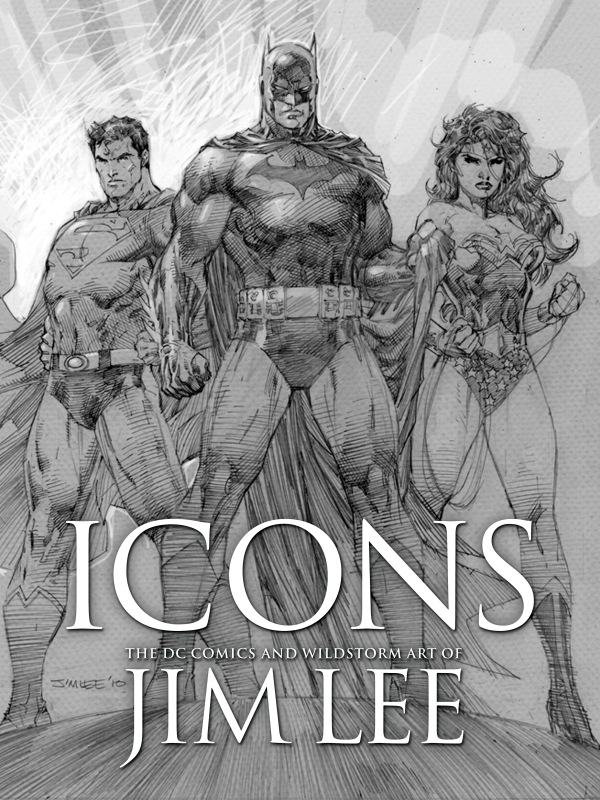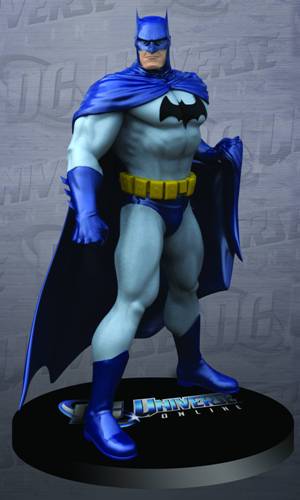Jim Lee's Career Profiled in Titan's PREVIEWS Exclusive Icons Artbook
 Twenty years ago Jim Lee's X-Men #1 became the best-selling comic book of all time, selling 7.7 million copies. His detailed, dynamic artwork made him a fan-favorite, and he became one of the founding partners of Image Comics, creating books such as WildC.A.T.s and Deathblow and helping creators launch their own works, such as Kurt Busiek's Astro City. Today, Lee is the Co-Publisher of DC Comics. His WildStorm imprint, home to WildC.A.T.s and its universe, is a vibrant part of the DC Comics publishing empire. He has worked on Batman and Superman. His character designs have become the face of DC Comics on merchandise, he is a guiding force behind the design of the upcoming MMORPG DC Online.
Twenty years ago Jim Lee's X-Men #1 became the best-selling comic book of all time, selling 7.7 million copies. His detailed, dynamic artwork made him a fan-favorite, and he became one of the founding partners of Image Comics, creating books such as WildC.A.T.s and Deathblow and helping creators launch their own works, such as Kurt Busiek's Astro City. Today, Lee is the Co-Publisher of DC Comics. His WildStorm imprint, home to WildC.A.T.s and its universe, is a vibrant part of the DC Comics publishing empire. He has worked on Batman and Superman. His character designs have become the face of DC Comics on merchandise, he is a guiding force behind the design of the upcoming MMORPG DC Online.
This summer, Titan Books takes a look back at Lee's varied and ground-breaking career with Icons: The DC and WildStorm Art of Jim Lee (MAY101117F, $49.95), a retrospective look at Lee's work on the characters of the DC and WildStorm universes presented through interviews and galleries of his work. In addition to an interview with Bill Baker, the most comprehensive interview Lee has given, that covers the breadth of his career, fans will find an exclusive 10-page Legion of Super-Heroes story written by Paul Levitz and drawn by Lee, and artwork drawn from Lee's archives of the DC and WildStorm universes. The PREVIEWS Exclusive edition of Icons features a special Lee cover and additional pages of rare Lee artwork. No fan of Jim Lee and no student of comics history will want to miss out on this intimate look into the mind of one of comics' legendary creators.
PREVIEWS writer Allyn Gibson sat down to talk with Lee about Icons and his work in the industry, and here's what he had to say about Icons, breaking into the industry, his career, and his new role at DC Entertainment as Co-Publisher:
PREVIEWS: How did you break into the industry?
LEE: I went to a convention in New York City and showed my samples to Archie Goodwin, who was working at Marvel at the time, and he liked my samples and invited me to come in and show them to an editor who worked with a lot of new talent named Carl Potts, who gave me my first assignment at Marvel, Alpha Flight.
PREVIEWS: What is your working process like? When you sit down to draw, what happens at the drawing board?
LEE: I lay out and draw straight on the page. I find that in experimenting with all these different ways of working, the more I prep for the final drawing, the stiffer and less dynamic the final drawing is, so I used to do thumbnails and then blow them up and transfer them and then redraw over them, and I was just losing energy and motion from the figures I was transferring and drawing. I found it was best just to do my "underdrawing" right on the actual board, then lightly erase it and draw on top, to use the light underdrawing as an architectural understructure for the final pencils, and that's worked pretty well for me. I even experimented with blue pencil and drawing on top of blue pencil, and all these different methods have their pros and cons, but one day I found it was easiest to go straight to pencil and paper.
PREVIEWS: Are you working on art boards today? Or have you moved to working on a graphics tablet like others in the industry? What advantages do you see to one or the other?
LEE: I have both, though I draw almost everything on the art board.
There's a part of me that likes having materials in hand. Working on tablet, even though you can draw straight onto the screen, still feels like computer work to me. Drawing on a board, it feels more like art. It creates the same result, which is art, the process of which you create using Photoshop or other programs, and you have more options using a computer program, which is great, but at the same time you have to construct your final image in a different way and a different order, sometimes. The tablet gives you a lot of freedom, but at the same time it's just a tool.
The very start of either process, whether you go traditional on paper or digital, you have to have a pretty clear idea of what you want to create in your mind, and that has remained consistent.
 PREVIEWS: What can readers expect to find in Icons: The DC and WildStorm Art of Jim Lee, coming out from Titan Books this summer?
PREVIEWS: What can readers expect to find in Icons: The DC and WildStorm Art of Jim Lee, coming out from Titan Books this summer?
LEE: It will have a lot of my work from DC, an extensive, multi-year interview I did with Bill Baker, done over many many years, probably the most comprehensive interview I've ever given. It has a ten- page Legion of Super-Heroes story that's exclusive to this book that I worked with Paul Levitz on, and that's been a real treat, just drawing these characters, some of my childhood favorites, and I've never drawn some of these guys in these costumes before. And it's going to have a lot of behind-the-scenes images, sketches, and photographs that have never been in print before, so a real treasure trove of things.
PREVIEWS: How did you get involved with DC Online? And what do you find rewarding about working on it?
LEE: I was an avid MMO player, like on EverQuest and Ultima Online, so I had a lot of experience playing these kinds of games, and when I found out that DC was thinking of licensing the characters for a massively multiplayer online experience, I volunteered for it. "I know the DCU, I know how these characters should look, and I have experience in how these games should feel and play." I guess I convinced them, because they made me the Executive Creative Director on the project, and I've been with it from the very, very start, four years ago, five years ago.
It's immensely rewarding in that it is a translation of our 2-D drawings into 3-Dimensional space. It's the first that that gamers, both hardcore and casual, are going to see a lot of the DC library of characters in 3-D format in a video game space. Everyone's seen the Batman and Superman games, even Justice League, but we've got hundreds of heroes and villains from the DCU, and you're going to see environments, headquarters, and secondary and tertiary characters that you never thought would ever be in a video game. Now you're going to be able to go on these incredible missions as a hero or villain, in Metropolis or Gotham City or a bunch of other environments that we've built out for the game.
What's interesting is that after the very first pass working through the villains, in a lot of MMOs when you get to the main boss, you find these gigantic dragons or creatures, and what you find in the comic book space is that most of the villains, most of the heroes and antagonists, are humanoid sized and shaped, and we had to look over the rogues' gallery and find out which ones we could exploit and make more monstrous or larger on screen to create some visual variation. You don't want to get to the final level of the lair and find a guy that's the same height as you, taking four or five players beating down this small character. We took a path on characters like Doomsday and made them larger and more fearsome, and that turned out pretty cool. We're able to go through and kind of tweak various parts of the DCU to make them more visually interesting for the game experience. As we start doing that, we start tweaking the DCU here and there visually, again, to kind of make it look really cool using the technology that these games afford you. That's been really rewarding and challenging and a lot of fun to see. I think the fans are going to dig it, because there are more than a few characters where they'll go, "I know who that is, but wow, I have not seen someone that badass looking before." I think that's the goal we're shooting for.

|
|
|
DC Direct's DC Universe Online: Batman Statue (APR100299X), based on Jim Lee's in-game artwork |
PREVIEWS: Do you see your work on DCU Online influencing the look and feel of DC Comics in the years to come, with some of these redesigns making the leap back from the game and into the comics?
LEE: I think that was the goal. Dan Didio and I have been in contact through this whole process about how we can take some of the design work, not just on the character side but even in terms of the infrastructure we created that didn't really exist on paper for DCUO. There has always been a map for Gotham City, or recently there's been a physical layout for what its state looks like, but there was never one for Metropolis. So we actually had to build one from scratch using references and tiled it together based on our knowledge of comics lore, but also in a way that would make for a cool gaming experience. We did that for anything and everything that didn't really exist like that.
When creators create comics, they tend to make what they need for the purpose of the story — locate the base where it needs to be, have three rooms on a floor if the story needs three rooms. But there's no bible that basically lays all this stuff out and defines the number of rooms on this floor, how many floors this building is. Yet, for this game, we needed that kind of documentation, so we created all of that stuff and designed it all, and now it exists in three-dimensional space. It's pretty exciting.
PREVIEWS: How do you feel about your new role at DC Comics as Co-Publisher, and where do you see the company going over the next five years?
LEE: The new role has been challenging.
Nothing can really prepare you for the amount of work involved in a transition like this. I think challenging in the best of senses, in that everyday a new problem comes up. I had some experience in this when I was running my own shop under Image, but not to the size and scale and degree of DC Comics, so every day I'm dealing with different aspects of the publishing business, whether it's what's going to happen on the digital front, what's going on with all of these games licensing these characters, there are requests for use of these characters in other media. Every day I feel like I'm having to learn a new subject, cram for it, and then have to pass the final, all before the next meeting. It's been a real educational and exhilarating experience thus far, so on that front it's been super-exciting and interesting.
On the creative level, I think the fact that we are getting close to announcing what we'll be doing over the next five years has been very exciting. Just strategizing, looking at data, talking to the various people in all the different departments that comprise DC Comics and figuring out a game plan and getting people excited about that, I think that's the fun part about publishing. Leading the way, deciding what comic books are going to be like going forward into the 2010s, and that's been a big part of what we've been tasked to handle.
It's been going great thus far. It's overwhelming, but in a good way, because I can see all the different businesses that DC Comics is involved in and all the different ways that your involvement and input can better the industry, the company, and comics in general.
PREVIEWS: What advice would you give to an artist looking to break into the industry today?
LEE: I tried breaking into the industry when I was twenty-one, and if I were twenty-one today, if I were fifteen today, because that's the age when I really thought about it as a career, I'd have my artwork online. I'd have pages online, I'd be involved in networking and communicating with other creators.
What's great about our industry is that there's amazing access to not just the other creators but to editors, co-publishers, heads of marketing. There's a level of access that doesn't exist in a lot other industries our size and our stature, and I think that's amazing for the opportunity to break in. Back then, I learned how to break in by reading old magazines, old fanzines I bought for like a quarter at a comic book shop. I'd network with a guy in the shop who knew that knew a guy that broke into comics. That's how you found out. And today, the amount of resources out there on the Internet is staggering, and that part's not going to hold you back. At this point, it's more competitive because there are more people trying to break in, but at the same time the thing that will hold you back is a lack of talent or a lack of discipline. Those are the two things, as a young artist trying to get into the industry — you have to be persistent, not just in terms of trying to get in, but also in terms of your work. You can't give up on it, you can't just draw when you feel like it, you have to treat it like it's a job for you already, get up, draw, put in your time, and then go off and do what other young people do. You have to be serious about it. Drawing is recreational, it's vocational, it's fun to do, but when you get into the business of drawing, when you get into commercial art, it is a job with its responsibilities and you have to take it seriously. And if you take it seriously, it will reward you back in ways you cannot imagine.
PREVIEWS: Jim, thank you for time. Best of luck with everything at DC Comics.
LEE: Thank you.
|
Order Titan's Icons: The DC & WildStorm Art of |
Initial Orders Online: Click here!
By Email: Click here!
By Phone: 800-45-COMIC
By Fax: 800-329-2878 or 410-560-3875


